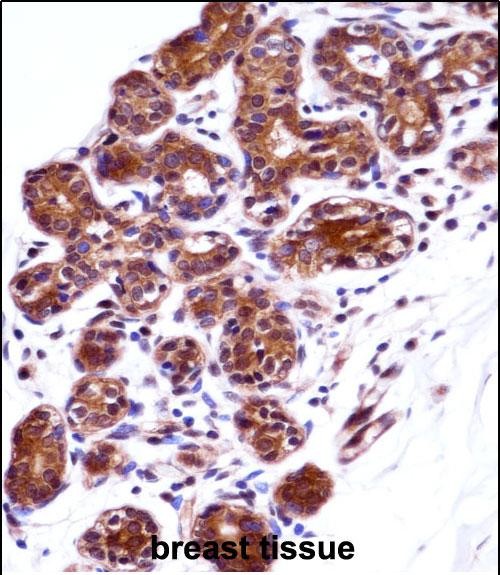IMPDH1 Antibody (N-term)
Affinity Purified Rabbit Polyclonal Antibody (Pab)
- 产品详情
- 实验流程
- 背景知识
Application
| WB, IHC-P, E |
|---|---|
| Primary Accession | P20839 |
| Other Accession | D3ZLZ7, P50096, Q6GMG5, A0JNA3, NP_001136045.1, NP_899066.1, NP_001096075.1 |
| Reactivity | Human |
| Predicted | Bovine, Zebrafish, Mouse, Rat |
| Host | Rabbit |
| Clonality | Polyclonal |
| Isotype | Rabbit IgG |
| Calculated MW | 55406 Da |
| Antigen Region | 84-113 aa |
| Gene ID | 3614 |
|---|---|
| Other Names | Inosine-5'-monophosphate dehydrogenase 1 {ECO:0000255|HAMAP-Rule:MF_03156}, IMP dehydrogenase 1 {ECO:0000255|HAMAP-Rule:MF_03156}, IMPD 1 {ECO:0000255|HAMAP-Rule:MF_03156}, IMPDH 1 {ECO:0000255|HAMAP-Rule:MF_03156}, 111205 {ECO:0000255|HAMAP-Rule:MF_03156}, IMPDH-I, IMPDH1 {ECO:0000255|HAMAP-Rule:MF_03156}, IMPD1 |
| Target/Specificity | This IMPDH1 antibody is generated from rabbits immunized with a KLH conjugated synthetic peptide between 84-113 amino acids from the N-terminal region of human IMPDH1. |
| Dilution | WB~~1:1000 IHC-P~~1:100~500 E~~Use at an assay dependent concentration. |
| Format | Purified polyclonal antibody supplied in PBS with 0.09% (W/V) sodium azide. This antibody is purified through a protein A column, followed by peptide affinity purification. |
| Storage | Maintain refrigerated at 2-8°C for up to 2 weeks. For long term storage store at -20°C in small aliquots to prevent freeze-thaw cycles. |
| Precautions | IMPDH1 Antibody (N-term) is for research use only and not for use in diagnostic or therapeutic procedures. |
| Name | IMPDH1 {ECO:0000255|HAMAP-Rule:MF_03156} |
|---|---|
| Synonyms | IMPD1 |
| Function | Catalyzes the conversion of inosine 5'-phosphate (IMP) to xanthosine 5'-phosphate (XMP), the first committed and rate-limiting step in the de novo synthesis of guanine nucleotides, and therefore plays an important role in the regulation of cell growth. Could also have a single-stranded nucleic acid-binding activity and could play a role in RNA and/or DNA metabolism. It may also have a role in the development of malignancy and the growth progression of some tumors. |
| Cellular Location | Cytoplasm {ECO:0000255|HAMAP-Rule:MF_03156, ECO:0000269|PubMed:14766016}. Nucleus {ECO:0000255|HAMAP-Rule:MF_03156, ECO:0000269|PubMed:14766016} |
| Tissue Location | IMP type I is the main species in normal leukocytes and type II predominates over type I in the tumor |
For Research Use Only. Not For Use In Diagnostic Procedures.
Provided below are standard protocols that you may find useful for product applications.
BACKGROUND
The protein encoded by this gene acts as a homotetramer to regulate cell growth. The encoded protein is an enzyme that catalyzes the synthesis of xanthine monophosphate (XMP) from inosine-5'-monophosphate (IMP). This is the rate-limiting step in the de novo synthesis of guanine nucleotides. Defects in this gene are a cause of retinitis pigmentosa type 10 (RP10). Several transcript variants encoding different isoforms have been found for this gene.
REFERENCES
Ohmann, E.L., et al. Pediatr Transplant 14(7):891-895(2010)
Gensburger, O., et al. Pharmacogenet. Genomics 20(9):537-543(2010)
Kagaya, H., et al. Basic Clin. Pharmacol. Toxicol. 107(2):631-636(2010)
Ohmann, E.L., et al. J. Heart Lung Transplant. 29(5):509-516(2010)
Shumei, L., et al. Adv. Exp. Med. Biol. 664, 293-297 (2010) :
终于等到您。ABCEPTA(百远生物)抗体产品。
点击下方“我要评价 ”按钮提交您的反馈信息,您的反馈和评价是我们最宝贵的财富之一,
我们将在1-3个工作日内处理您的反馈信息。
如有疑问,联系:0512-88856768 tech-china@abcepta.com.























 癌症的基本特征包括细胞增殖、血管生成、迁移、凋亡逃避机制和细胞永生等。找到癌症发生过程中这些通路的关键标记物和对应的抗体用于检测至关重要。
癌症的基本特征包括细胞增殖、血管生成、迁移、凋亡逃避机制和细胞永生等。找到癌症发生过程中这些通路的关键标记物和对应的抗体用于检测至关重要。 为您推荐一个泛素化位点预测神器——泛素化分析工具,可以为您的蛋白的泛素化位点作出预测和评分。
为您推荐一个泛素化位点预测神器——泛素化分析工具,可以为您的蛋白的泛素化位点作出预测和评分。 细胞自噬受体图形绘图工具为你的蛋白的细胞受体结合位点作出预测和评分,识别结合到自噬通路中的蛋白是非常重要的,便于让我们理解自噬在正常生理、病理过程中的作用,如发育、细胞分化、神经退化性疾病、压力条件下、感染和癌症。
细胞自噬受体图形绘图工具为你的蛋白的细胞受体结合位点作出预测和评分,识别结合到自噬通路中的蛋白是非常重要的,便于让我们理解自噬在正常生理、病理过程中的作用,如发育、细胞分化、神经退化性疾病、压力条件下、感染和癌症。







